Contract Law: Essentials and Applications
VerifiedAdded on 2020/02/14
|17
|6193
|96
AI Summary
This assignment delves into the core concepts of contract law. It examines essential elements such as offer, acceptance, consideration, and intention to create legal relations. Various types of contracts are explored, including express and implied terms. The assignment also analyzes relevant case laws like Harvey v Facey and Felthouse v Bindley, illustrating practical applications of contract law principles. Lastly, it touches upon contemporary topics like outsourcing and vicarious liability within the context of contracts.
Contribute Materials
Your contribution can guide someone’s learning journey. Share your
documents today.
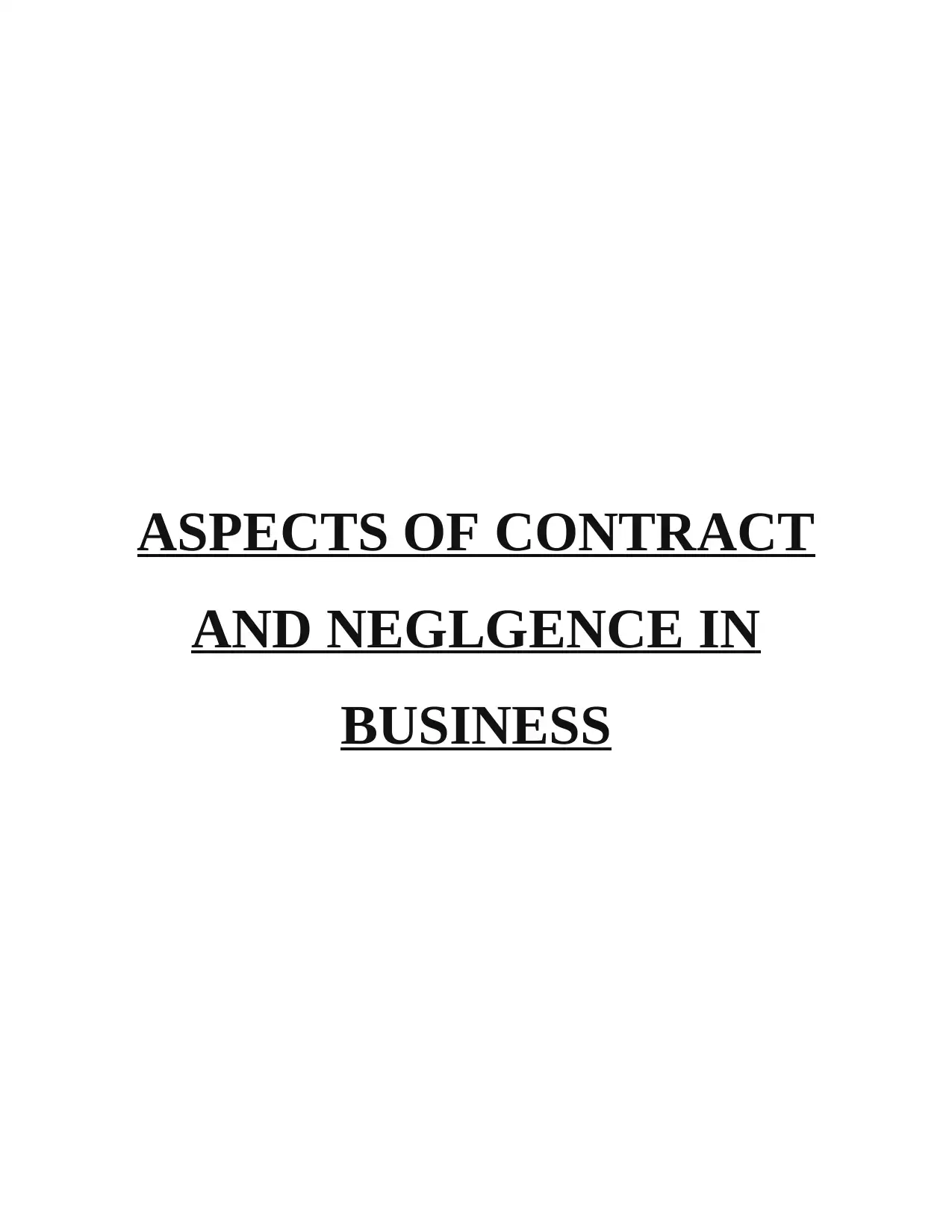
ASPECTS OF CONTRACT
AND NEGLGENCE IN
BUSINESS
AND NEGLGENCE IN
BUSINESS
Secure Best Marks with AI Grader
Need help grading? Try our AI Grader for instant feedback on your assignments.
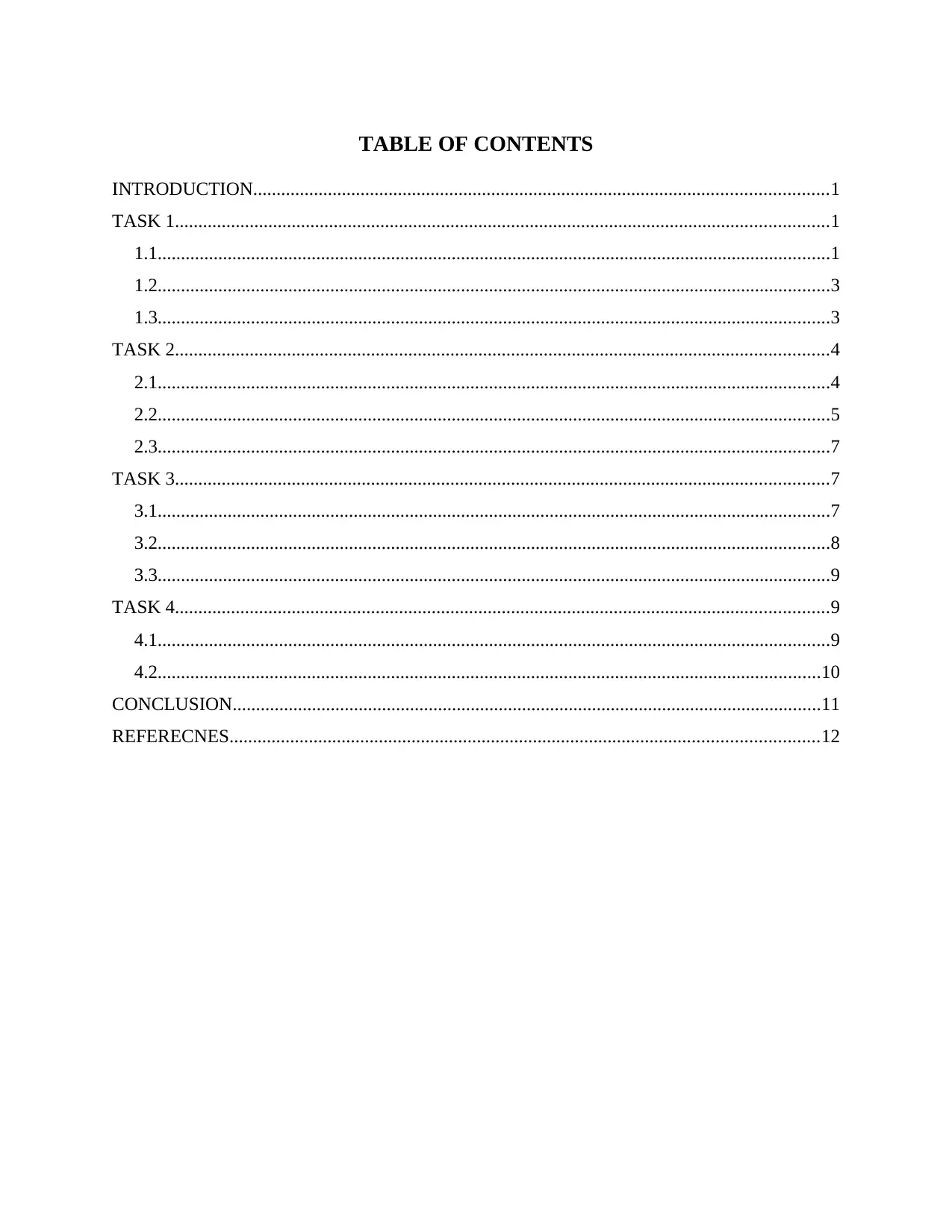
TABLE OF CONTENTS
INTRODUCTION...........................................................................................................................1
TASK 1............................................................................................................................................1
1.1................................................................................................................................................1
1.2................................................................................................................................................3
1.3................................................................................................................................................3
TASK 2............................................................................................................................................4
2.1................................................................................................................................................4
2.2................................................................................................................................................5
2.3................................................................................................................................................7
TASK 3............................................................................................................................................7
3.1................................................................................................................................................7
3.2................................................................................................................................................8
3.3................................................................................................................................................9
TASK 4............................................................................................................................................9
4.1................................................................................................................................................9
4.2..............................................................................................................................................10
CONCLUSION..............................................................................................................................11
REFERECNES..............................................................................................................................12
INTRODUCTION...........................................................................................................................1
TASK 1............................................................................................................................................1
1.1................................................................................................................................................1
1.2................................................................................................................................................3
1.3................................................................................................................................................3
TASK 2............................................................................................................................................4
2.1................................................................................................................................................4
2.2................................................................................................................................................5
2.3................................................................................................................................................7
TASK 3............................................................................................................................................7
3.1................................................................................................................................................7
3.2................................................................................................................................................8
3.3................................................................................................................................................9
TASK 4............................................................................................................................................9
4.1................................................................................................................................................9
4.2..............................................................................................................................................10
CONCLUSION..............................................................................................................................11
REFERECNES..............................................................................................................................12

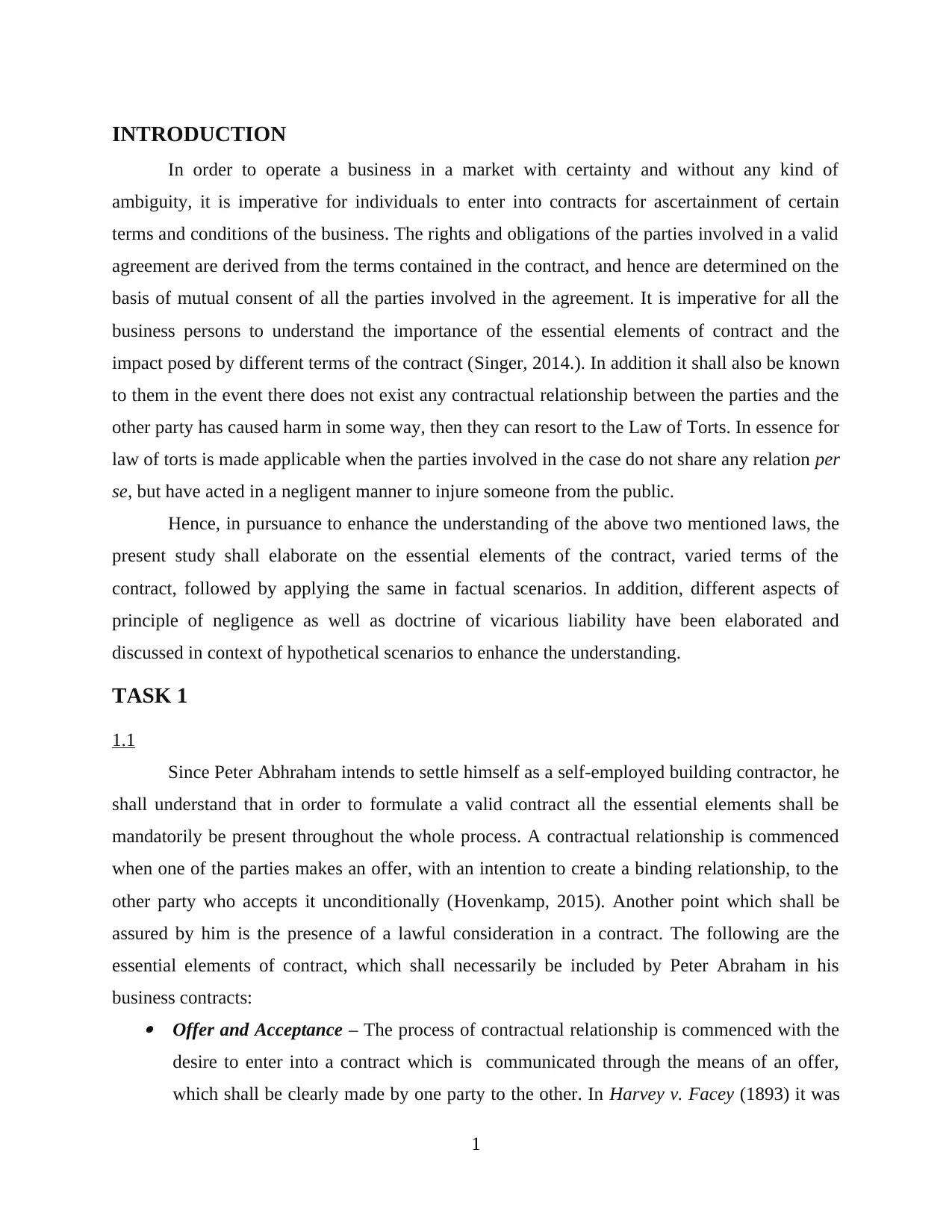
INTRODUCTION
In order to operate a business in a market with certainty and without any kind of
ambiguity, it is imperative for individuals to enter into contracts for ascertainment of certain
terms and conditions of the business. The rights and obligations of the parties involved in a valid
agreement are derived from the terms contained in the contract, and hence are determined on the
basis of mutual consent of all the parties involved in the agreement. It is imperative for all the
business persons to understand the importance of the essential elements of contract and the
impact posed by different terms of the contract (Singer, 2014.). In addition it shall also be known
to them in the event there does not exist any contractual relationship between the parties and the
other party has caused harm in some way, then they can resort to the Law of Torts. In essence for
law of torts is made applicable when the parties involved in the case do not share any relation per
se, but have acted in a negligent manner to injure someone from the public.
Hence, in pursuance to enhance the understanding of the above two mentioned laws, the
present study shall elaborate on the essential elements of the contract, varied terms of the
contract, followed by applying the same in factual scenarios. In addition, different aspects of
principle of negligence as well as doctrine of vicarious liability have been elaborated and
discussed in context of hypothetical scenarios to enhance the understanding.
TASK 1
1.1
Since Peter Abhraham intends to settle himself as a self-employed building contractor, he
shall understand that in order to formulate a valid contract all the essential elements shall be
mandatorily be present throughout the whole process. A contractual relationship is commenced
when one of the parties makes an offer, with an intention to create a binding relationship, to the
other party who accepts it unconditionally (Hovenkamp, 2015). Another point which shall be
assured by him is the presence of a lawful consideration in a contract. The following are the
essential elements of contract, which shall necessarily be included by Peter Abraham in his
business contracts: Offer and Acceptance – The process of contractual relationship is commenced with the
desire to enter into a contract which is communicated through the means of an offer,
which shall be clearly made by one party to the other. In Harvey v. Facey (1893) it was
1
In order to operate a business in a market with certainty and without any kind of
ambiguity, it is imperative for individuals to enter into contracts for ascertainment of certain
terms and conditions of the business. The rights and obligations of the parties involved in a valid
agreement are derived from the terms contained in the contract, and hence are determined on the
basis of mutual consent of all the parties involved in the agreement. It is imperative for all the
business persons to understand the importance of the essential elements of contract and the
impact posed by different terms of the contract (Singer, 2014.). In addition it shall also be known
to them in the event there does not exist any contractual relationship between the parties and the
other party has caused harm in some way, then they can resort to the Law of Torts. In essence for
law of torts is made applicable when the parties involved in the case do not share any relation per
se, but have acted in a negligent manner to injure someone from the public.
Hence, in pursuance to enhance the understanding of the above two mentioned laws, the
present study shall elaborate on the essential elements of the contract, varied terms of the
contract, followed by applying the same in factual scenarios. In addition, different aspects of
principle of negligence as well as doctrine of vicarious liability have been elaborated and
discussed in context of hypothetical scenarios to enhance the understanding.
TASK 1
1.1
Since Peter Abhraham intends to settle himself as a self-employed building contractor, he
shall understand that in order to formulate a valid contract all the essential elements shall be
mandatorily be present throughout the whole process. A contractual relationship is commenced
when one of the parties makes an offer, with an intention to create a binding relationship, to the
other party who accepts it unconditionally (Hovenkamp, 2015). Another point which shall be
assured by him is the presence of a lawful consideration in a contract. The following are the
essential elements of contract, which shall necessarily be included by Peter Abraham in his
business contracts: Offer and Acceptance – The process of contractual relationship is commenced with the
desire to enter into a contract which is communicated through the means of an offer,
which shall be clearly made by one party to the other. In Harvey v. Facey (1893) it was
1
Secure Best Marks with AI Grader
Need help grading? Try our AI Grader for instant feedback on your assignments.
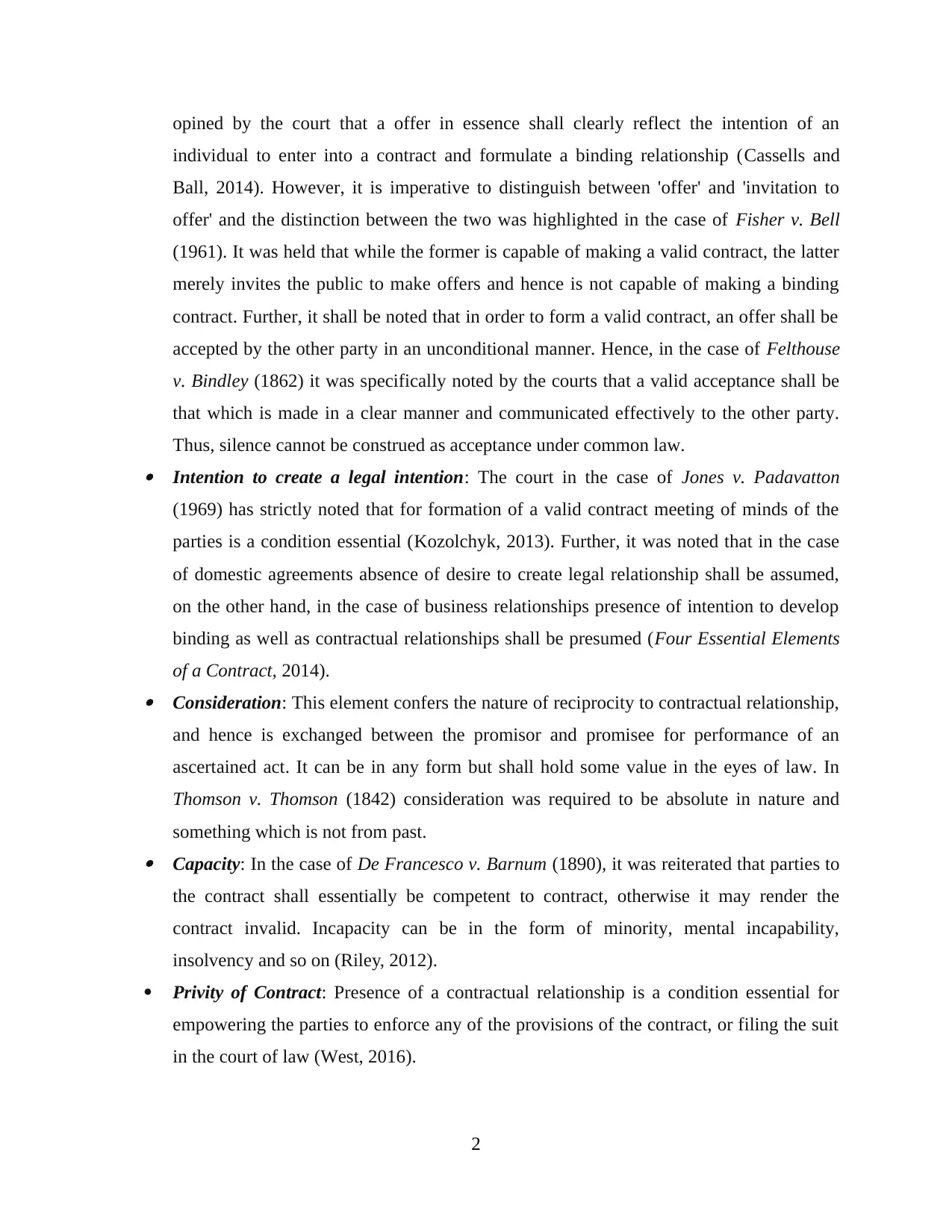
opined by the court that a offer in essence shall clearly reflect the intention of an
individual to enter into a contract and formulate a binding relationship (Cassells and
Ball, 2014). However, it is imperative to distinguish between 'offer' and 'invitation to
offer' and the distinction between the two was highlighted in the case of Fisher v. Bell
(1961). It was held that while the former is capable of making a valid contract, the latter
merely invites the public to make offers and hence is not capable of making a binding
contract. Further, it shall be noted that in order to form a valid contract, an offer shall be
accepted by the other party in an unconditional manner. Hence, in the case of Felthouse
v. Bindley (1862) it was specifically noted by the courts that a valid acceptance shall be
that which is made in a clear manner and communicated effectively to the other party.
Thus, silence cannot be construed as acceptance under common law. Intention to create a legal intention: The court in the case of Jones v. Padavatton
(1969) has strictly noted that for formation of a valid contract meeting of minds of the
parties is a condition essential (Kozolchyk, 2013). Further, it was noted that in the case
of domestic agreements absence of desire to create legal relationship shall be assumed,
on the other hand, in the case of business relationships presence of intention to develop
binding as well as contractual relationships shall be presumed (Four Essential Elements
of a Contract, 2014). Consideration: This element confers the nature of reciprocity to contractual relationship,
and hence is exchanged between the promisor and promisee for performance of an
ascertained act. It can be in any form but shall hold some value in the eyes of law. In
Thomson v. Thomson (1842) consideration was required to be absolute in nature and
something which is not from past. Capacity: In the case of De Francesco v. Barnum (1890), it was reiterated that parties to
the contract shall essentially be competent to contract, otherwise it may render the
contract invalid. Incapacity can be in the form of minority, mental incapability,
insolvency and so on (Riley, 2012).
Privity of Contract: Presence of a contractual relationship is a condition essential for
empowering the parties to enforce any of the provisions of the contract, or filing the suit
in the court of law (West, 2016).
2
individual to enter into a contract and formulate a binding relationship (Cassells and
Ball, 2014). However, it is imperative to distinguish between 'offer' and 'invitation to
offer' and the distinction between the two was highlighted in the case of Fisher v. Bell
(1961). It was held that while the former is capable of making a valid contract, the latter
merely invites the public to make offers and hence is not capable of making a binding
contract. Further, it shall be noted that in order to form a valid contract, an offer shall be
accepted by the other party in an unconditional manner. Hence, in the case of Felthouse
v. Bindley (1862) it was specifically noted by the courts that a valid acceptance shall be
that which is made in a clear manner and communicated effectively to the other party.
Thus, silence cannot be construed as acceptance under common law. Intention to create a legal intention: The court in the case of Jones v. Padavatton
(1969) has strictly noted that for formation of a valid contract meeting of minds of the
parties is a condition essential (Kozolchyk, 2013). Further, it was noted that in the case
of domestic agreements absence of desire to create legal relationship shall be assumed,
on the other hand, in the case of business relationships presence of intention to develop
binding as well as contractual relationships shall be presumed (Four Essential Elements
of a Contract, 2014). Consideration: This element confers the nature of reciprocity to contractual relationship,
and hence is exchanged between the promisor and promisee for performance of an
ascertained act. It can be in any form but shall hold some value in the eyes of law. In
Thomson v. Thomson (1842) consideration was required to be absolute in nature and
something which is not from past. Capacity: In the case of De Francesco v. Barnum (1890), it was reiterated that parties to
the contract shall essentially be competent to contract, otherwise it may render the
contract invalid. Incapacity can be in the form of minority, mental incapability,
insolvency and so on (Riley, 2012).
Privity of Contract: Presence of a contractual relationship is a condition essential for
empowering the parties to enforce any of the provisions of the contract, or filing the suit
in the court of law (West, 2016).
2
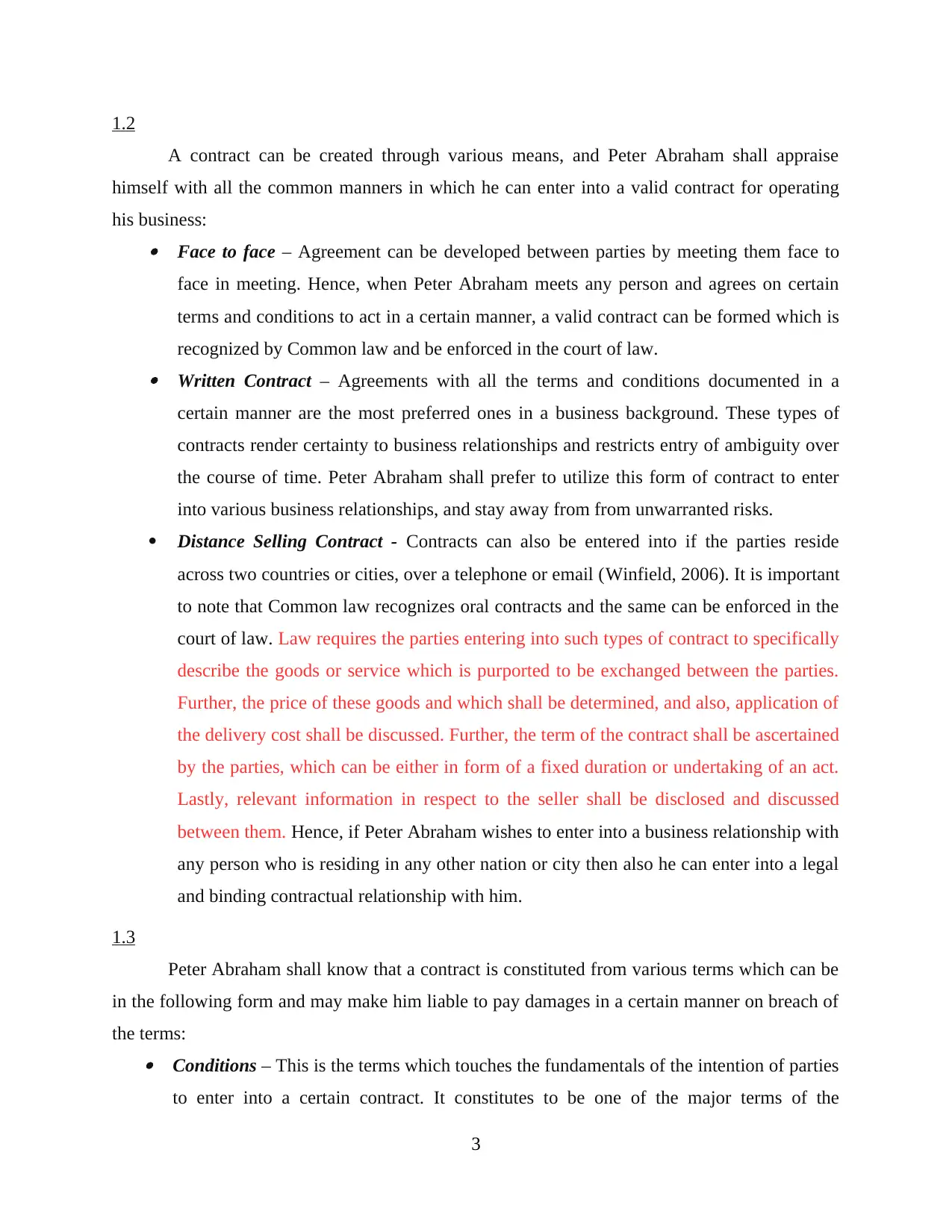
1.2
A contract can be created through various means, and Peter Abraham shall appraise
himself with all the common manners in which he can enter into a valid contract for operating
his business: Face to face – Agreement can be developed between parties by meeting them face to
face in meeting. Hence, when Peter Abraham meets any person and agrees on certain
terms and conditions to act in a certain manner, a valid contract can be formed which is
recognized by Common law and be enforced in the court of law. Written Contract – Agreements with all the terms and conditions documented in a
certain manner are the most preferred ones in a business background. These types of
contracts render certainty to business relationships and restricts entry of ambiguity over
the course of time. Peter Abraham shall prefer to utilize this form of contract to enter
into various business relationships, and stay away from from unwarranted risks.
Distance Selling Contract - Contracts can also be entered into if the parties reside
across two countries or cities, over a telephone or email (Winfield, 2006). It is important
to note that Common law recognizes oral contracts and the same can be enforced in the
court of law. Law requires the parties entering into such types of contract to specifically
describe the goods or service which is purported to be exchanged between the parties.
Further, the price of these goods and which shall be determined, and also, application of
the delivery cost shall be discussed. Further, the term of the contract shall be ascertained
by the parties, which can be either in form of a fixed duration or undertaking of an act.
Lastly, relevant information in respect to the seller shall be disclosed and discussed
between them. Hence, if Peter Abraham wishes to enter into a business relationship with
any person who is residing in any other nation or city then also he can enter into a legal
and binding contractual relationship with him.
1.3
Peter Abraham shall know that a contract is constituted from various terms which can be
in the following form and may make him liable to pay damages in a certain manner on breach of
the terms: Conditions – This is the terms which touches the fundamentals of the intention of parties
to enter into a certain contract. It constitutes to be one of the major terms of the
3
A contract can be created through various means, and Peter Abraham shall appraise
himself with all the common manners in which he can enter into a valid contract for operating
his business: Face to face – Agreement can be developed between parties by meeting them face to
face in meeting. Hence, when Peter Abraham meets any person and agrees on certain
terms and conditions to act in a certain manner, a valid contract can be formed which is
recognized by Common law and be enforced in the court of law. Written Contract – Agreements with all the terms and conditions documented in a
certain manner are the most preferred ones in a business background. These types of
contracts render certainty to business relationships and restricts entry of ambiguity over
the course of time. Peter Abraham shall prefer to utilize this form of contract to enter
into various business relationships, and stay away from from unwarranted risks.
Distance Selling Contract - Contracts can also be entered into if the parties reside
across two countries or cities, over a telephone or email (Winfield, 2006). It is important
to note that Common law recognizes oral contracts and the same can be enforced in the
court of law. Law requires the parties entering into such types of contract to specifically
describe the goods or service which is purported to be exchanged between the parties.
Further, the price of these goods and which shall be determined, and also, application of
the delivery cost shall be discussed. Further, the term of the contract shall be ascertained
by the parties, which can be either in form of a fixed duration or undertaking of an act.
Lastly, relevant information in respect to the seller shall be disclosed and discussed
between them. Hence, if Peter Abraham wishes to enter into a business relationship with
any person who is residing in any other nation or city then also he can enter into a legal
and binding contractual relationship with him.
1.3
Peter Abraham shall know that a contract is constituted from various terms which can be
in the following form and may make him liable to pay damages in a certain manner on breach of
the terms: Conditions – This is the terms which touches the fundamentals of the intention of parties
to enter into a certain contract. It constitutes to be one of the major terms of the
3
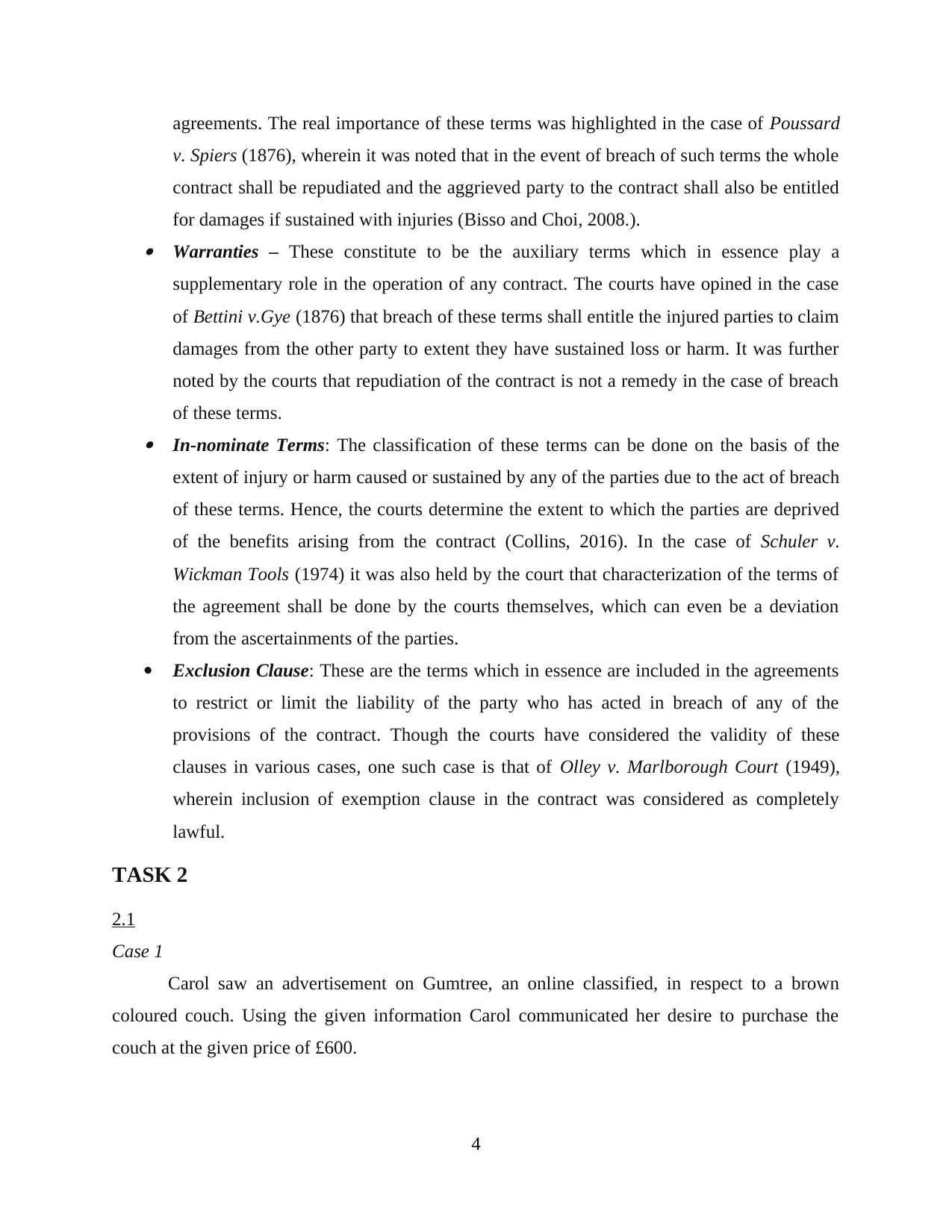
agreements. The real importance of these terms was highlighted in the case of Poussard
v. Spiers (1876), wherein it was noted that in the event of breach of such terms the whole
contract shall be repudiated and the aggrieved party to the contract shall also be entitled
for damages if sustained with injuries (Bisso and Choi, 2008.). Warranties – These constitute to be the auxiliary terms which in essence play a
supplementary role in the operation of any contract. The courts have opined in the case
of Bettini v.Gye (1876) that breach of these terms shall entitle the injured parties to claim
damages from the other party to extent they have sustained loss or harm. It was further
noted by the courts that repudiation of the contract is not a remedy in the case of breach
of these terms. In-nominate Terms: The classification of these terms can be done on the basis of the
extent of injury or harm caused or sustained by any of the parties due to the act of breach
of these terms. Hence, the courts determine the extent to which the parties are deprived
of the benefits arising from the contract (Collins, 2016). In the case of Schuler v.
Wickman Tools (1974) it was also held by the court that characterization of the terms of
the agreement shall be done by the courts themselves, which can even be a deviation
from the ascertainments of the parties.
Exclusion Clause: These are the terms which in essence are included in the agreements
to restrict or limit the liability of the party who has acted in breach of any of the
provisions of the contract. Though the courts have considered the validity of these
clauses in various cases, one such case is that of Olley v. Marlborough Court (1949),
wherein inclusion of exemption clause in the contract was considered as completely
lawful.
TASK 2
2.1
Case 1
Carol saw an advertisement on Gumtree, an online classified, in respect to a brown
coloured couch. Using the given information Carol communicated her desire to purchase the
couch at the given price of £600.
4
v. Spiers (1876), wherein it was noted that in the event of breach of such terms the whole
contract shall be repudiated and the aggrieved party to the contract shall also be entitled
for damages if sustained with injuries (Bisso and Choi, 2008.). Warranties – These constitute to be the auxiliary terms which in essence play a
supplementary role in the operation of any contract. The courts have opined in the case
of Bettini v.Gye (1876) that breach of these terms shall entitle the injured parties to claim
damages from the other party to extent they have sustained loss or harm. It was further
noted by the courts that repudiation of the contract is not a remedy in the case of breach
of these terms. In-nominate Terms: The classification of these terms can be done on the basis of the
extent of injury or harm caused or sustained by any of the parties due to the act of breach
of these terms. Hence, the courts determine the extent to which the parties are deprived
of the benefits arising from the contract (Collins, 2016). In the case of Schuler v.
Wickman Tools (1974) it was also held by the court that characterization of the terms of
the agreement shall be done by the courts themselves, which can even be a deviation
from the ascertainments of the parties.
Exclusion Clause: These are the terms which in essence are included in the agreements
to restrict or limit the liability of the party who has acted in breach of any of the
provisions of the contract. Though the courts have considered the validity of these
clauses in various cases, one such case is that of Olley v. Marlborough Court (1949),
wherein inclusion of exemption clause in the contract was considered as completely
lawful.
TASK 2
2.1
Case 1
Carol saw an advertisement on Gumtree, an online classified, in respect to a brown
coloured couch. Using the given information Carol communicated her desire to purchase the
couch at the given price of £600.
4
Paraphrase This Document
Need a fresh take? Get an instant paraphrase of this document with our AI Paraphraser
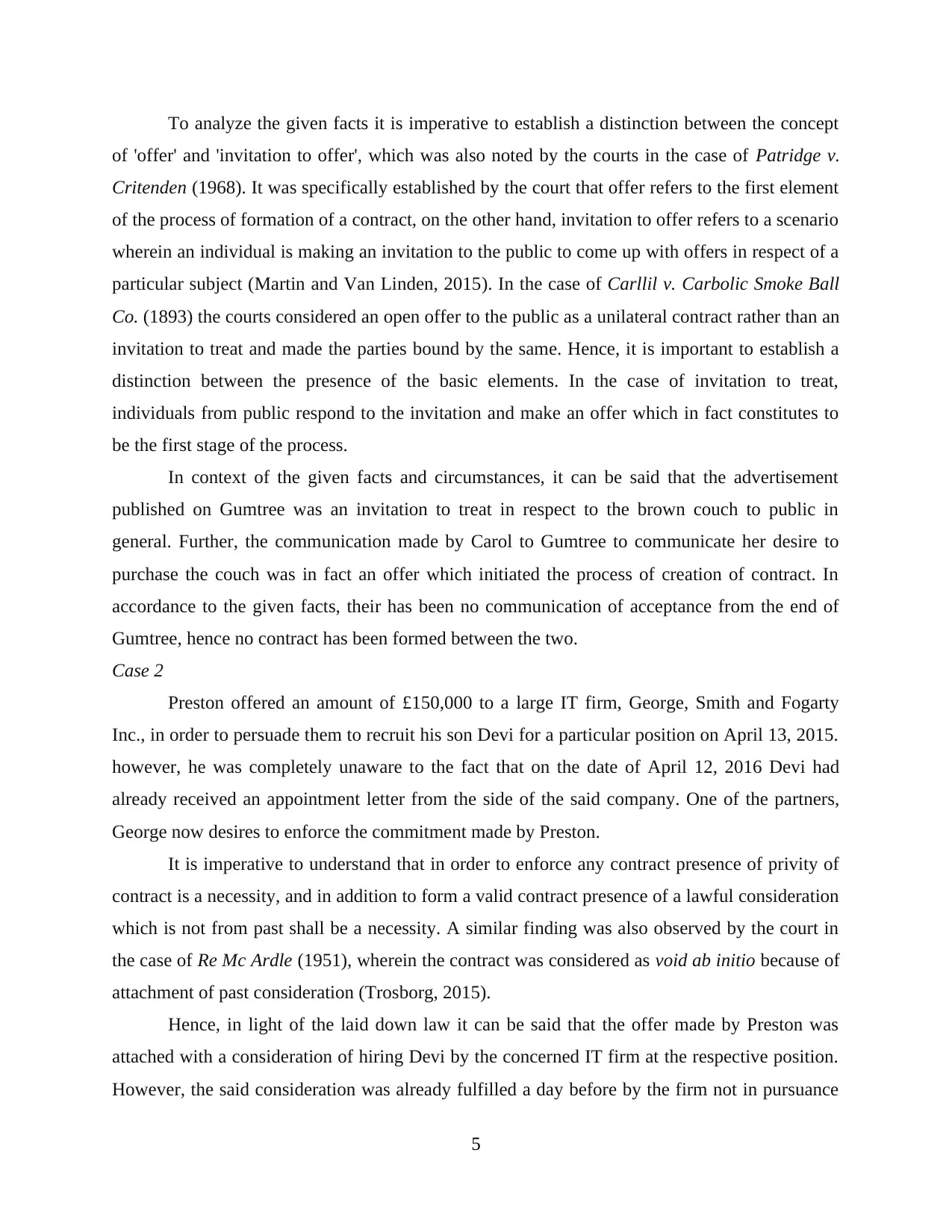
To analyze the given facts it is imperative to establish a distinction between the concept
of 'offer' and 'invitation to offer', which was also noted by the courts in the case of Patridge v.
Critenden (1968). It was specifically established by the court that offer refers to the first element
of the process of formation of a contract, on the other hand, invitation to offer refers to a scenario
wherein an individual is making an invitation to the public to come up with offers in respect of a
particular subject (Martin and Van Linden, 2015). In the case of Carllil v. Carbolic Smoke Ball
Co. (1893) the courts considered an open offer to the public as a unilateral contract rather than an
invitation to treat and made the parties bound by the same. Hence, it is important to establish a
distinction between the presence of the basic elements. In the case of invitation to treat,
individuals from public respond to the invitation and make an offer which in fact constitutes to
be the first stage of the process.
In context of the given facts and circumstances, it can be said that the advertisement
published on Gumtree was an invitation to treat in respect to the brown couch to public in
general. Further, the communication made by Carol to Gumtree to communicate her desire to
purchase the couch was in fact an offer which initiated the process of creation of contract. In
accordance to the given facts, their has been no communication of acceptance from the end of
Gumtree, hence no contract has been formed between the two.
Case 2
Preston offered an amount of £150,000 to a large IT firm, George, Smith and Fogarty
Inc., in order to persuade them to recruit his son Devi for a particular position on April 13, 2015.
however, he was completely unaware to the fact that on the date of April 12, 2016 Devi had
already received an appointment letter from the side of the said company. One of the partners,
George now desires to enforce the commitment made by Preston.
It is imperative to understand that in order to enforce any contract presence of privity of
contract is a necessity, and in addition to form a valid contract presence of a lawful consideration
which is not from past shall be a necessity. A similar finding was also observed by the court in
the case of Re Mc Ardle (1951), wherein the contract was considered as void ab initio because of
attachment of past consideration (Trosborg, 2015).
Hence, in light of the laid down law it can be said that the offer made by Preston was
attached with a consideration of hiring Devi by the concerned IT firm at the respective position.
However, the said consideration was already fulfilled a day before by the firm not in pursuance
5
of 'offer' and 'invitation to offer', which was also noted by the courts in the case of Patridge v.
Critenden (1968). It was specifically established by the court that offer refers to the first element
of the process of formation of a contract, on the other hand, invitation to offer refers to a scenario
wherein an individual is making an invitation to the public to come up with offers in respect of a
particular subject (Martin and Van Linden, 2015). In the case of Carllil v. Carbolic Smoke Ball
Co. (1893) the courts considered an open offer to the public as a unilateral contract rather than an
invitation to treat and made the parties bound by the same. Hence, it is important to establish a
distinction between the presence of the basic elements. In the case of invitation to treat,
individuals from public respond to the invitation and make an offer which in fact constitutes to
be the first stage of the process.
In context of the given facts and circumstances, it can be said that the advertisement
published on Gumtree was an invitation to treat in respect to the brown couch to public in
general. Further, the communication made by Carol to Gumtree to communicate her desire to
purchase the couch was in fact an offer which initiated the process of creation of contract. In
accordance to the given facts, their has been no communication of acceptance from the end of
Gumtree, hence no contract has been formed between the two.
Case 2
Preston offered an amount of £150,000 to a large IT firm, George, Smith and Fogarty
Inc., in order to persuade them to recruit his son Devi for a particular position on April 13, 2015.
however, he was completely unaware to the fact that on the date of April 12, 2016 Devi had
already received an appointment letter from the side of the said company. One of the partners,
George now desires to enforce the commitment made by Preston.
It is imperative to understand that in order to enforce any contract presence of privity of
contract is a necessity, and in addition to form a valid contract presence of a lawful consideration
which is not from past shall be a necessity. A similar finding was also observed by the court in
the case of Re Mc Ardle (1951), wherein the contract was considered as void ab initio because of
attachment of past consideration (Trosborg, 2015).
Hence, in light of the laid down law it can be said that the offer made by Preston was
attached with a consideration of hiring Devi by the concerned IT firm at the respective position.
However, the said consideration was already fulfilled a day before by the firm not in pursuance
5
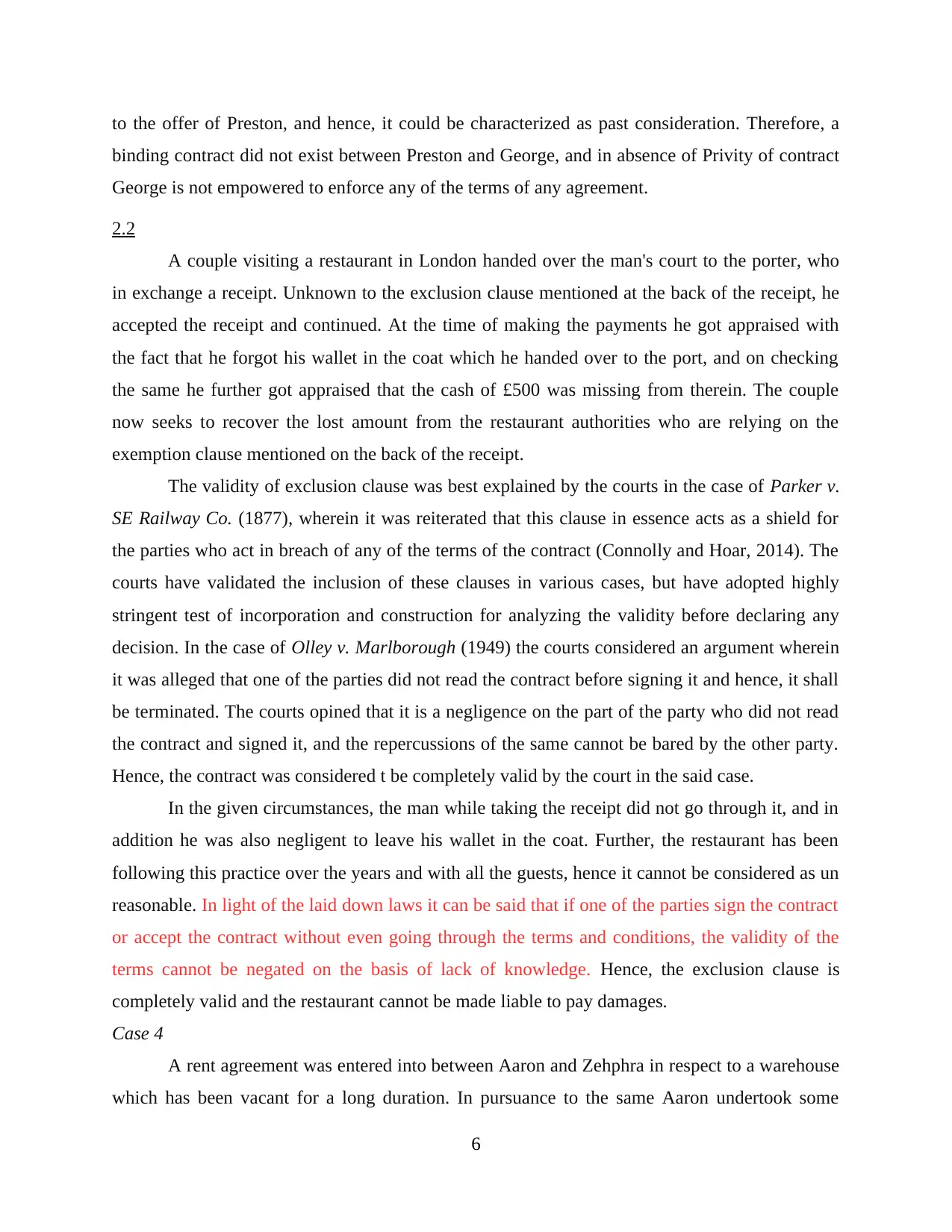
to the offer of Preston, and hence, it could be characterized as past consideration. Therefore, a
binding contract did not exist between Preston and George, and in absence of Privity of contract
George is not empowered to enforce any of the terms of any agreement.
2.2
A couple visiting a restaurant in London handed over the man's court to the porter, who
in exchange a receipt. Unknown to the exclusion clause mentioned at the back of the receipt, he
accepted the receipt and continued. At the time of making the payments he got appraised with
the fact that he forgot his wallet in the coat which he handed over to the port, and on checking
the same he further got appraised that the cash of £500 was missing from therein. The couple
now seeks to recover the lost amount from the restaurant authorities who are relying on the
exemption clause mentioned on the back of the receipt.
The validity of exclusion clause was best explained by the courts in the case of Parker v.
SE Railway Co. (1877), wherein it was reiterated that this clause in essence acts as a shield for
the parties who act in breach of any of the terms of the contract (Connolly and Hoar, 2014). The
courts have validated the inclusion of these clauses in various cases, but have adopted highly
stringent test of incorporation and construction for analyzing the validity before declaring any
decision. In the case of Olley v. Marlborough (1949) the courts considered an argument wherein
it was alleged that one of the parties did not read the contract before signing it and hence, it shall
be terminated. The courts opined that it is a negligence on the part of the party who did not read
the contract and signed it, and the repercussions of the same cannot be bared by the other party.
Hence, the contract was considered t be completely valid by the court in the said case.
In the given circumstances, the man while taking the receipt did not go through it, and in
addition he was also negligent to leave his wallet in the coat. Further, the restaurant has been
following this practice over the years and with all the guests, hence it cannot be considered as un
reasonable. In light of the laid down laws it can be said that if one of the parties sign the contract
or accept the contract without even going through the terms and conditions, the validity of the
terms cannot be negated on the basis of lack of knowledge. Hence, the exclusion clause is
completely valid and the restaurant cannot be made liable to pay damages.
Case 4
A rent agreement was entered into between Aaron and Zehphra in respect to a warehouse
which has been vacant for a long duration. In pursuance to the same Aaron undertook some
6
binding contract did not exist between Preston and George, and in absence of Privity of contract
George is not empowered to enforce any of the terms of any agreement.
2.2
A couple visiting a restaurant in London handed over the man's court to the porter, who
in exchange a receipt. Unknown to the exclusion clause mentioned at the back of the receipt, he
accepted the receipt and continued. At the time of making the payments he got appraised with
the fact that he forgot his wallet in the coat which he handed over to the port, and on checking
the same he further got appraised that the cash of £500 was missing from therein. The couple
now seeks to recover the lost amount from the restaurant authorities who are relying on the
exemption clause mentioned on the back of the receipt.
The validity of exclusion clause was best explained by the courts in the case of Parker v.
SE Railway Co. (1877), wherein it was reiterated that this clause in essence acts as a shield for
the parties who act in breach of any of the terms of the contract (Connolly and Hoar, 2014). The
courts have validated the inclusion of these clauses in various cases, but have adopted highly
stringent test of incorporation and construction for analyzing the validity before declaring any
decision. In the case of Olley v. Marlborough (1949) the courts considered an argument wherein
it was alleged that one of the parties did not read the contract before signing it and hence, it shall
be terminated. The courts opined that it is a negligence on the part of the party who did not read
the contract and signed it, and the repercussions of the same cannot be bared by the other party.
Hence, the contract was considered t be completely valid by the court in the said case.
In the given circumstances, the man while taking the receipt did not go through it, and in
addition he was also negligent to leave his wallet in the coat. Further, the restaurant has been
following this practice over the years and with all the guests, hence it cannot be considered as un
reasonable. In light of the laid down laws it can be said that if one of the parties sign the contract
or accept the contract without even going through the terms and conditions, the validity of the
terms cannot be negated on the basis of lack of knowledge. Hence, the exclusion clause is
completely valid and the restaurant cannot be made liable to pay damages.
Case 4
A rent agreement was entered into between Aaron and Zehphra in respect to a warehouse
which has been vacant for a long duration. In pursuance to the same Aaron undertook some
6
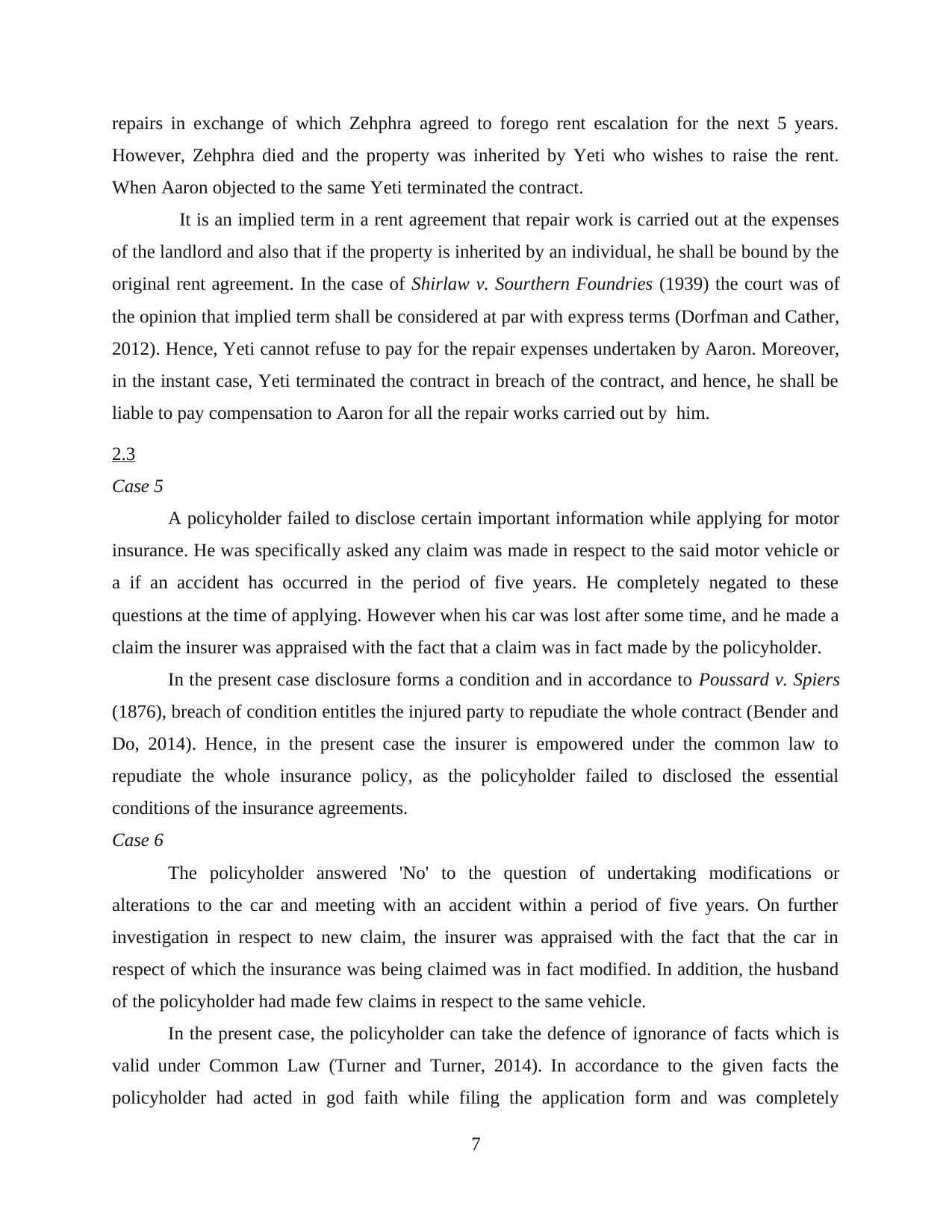
repairs in exchange of which Zehphra agreed to forego rent escalation for the next 5 years.
However, Zehphra died and the property was inherited by Yeti who wishes to raise the rent.
When Aaron objected to the same Yeti terminated the contract.
It is an implied term in a rent agreement that repair work is carried out at the expenses
of the landlord and also that if the property is inherited by an individual, he shall be bound by the
original rent agreement. In the case of Shirlaw v. Sourthern Foundries (1939) the court was of
the opinion that implied term shall be considered at par with express terms (Dorfman and Cather,
2012). Hence, Yeti cannot refuse to pay for the repair expenses undertaken by Aaron. Moreover,
in the instant case, Yeti terminated the contract in breach of the contract, and hence, he shall be
liable to pay compensation to Aaron for all the repair works carried out by him.
2.3
Case 5
A policyholder failed to disclose certain important information while applying for motor
insurance. He was specifically asked any claim was made in respect to the said motor vehicle or
a if an accident has occurred in the period of five years. He completely negated to these
questions at the time of applying. However when his car was lost after some time, and he made a
claim the insurer was appraised with the fact that a claim was in fact made by the policyholder.
In the present case disclosure forms a condition and in accordance to Poussard v. Spiers
(1876), breach of condition entitles the injured party to repudiate the whole contract (Bender and
Do, 2014). Hence, in the present case the insurer is empowered under the common law to
repudiate the whole insurance policy, as the policyholder failed to disclosed the essential
conditions of the insurance agreements.
Case 6
The policyholder answered 'No' to the question of undertaking modifications or
alterations to the car and meeting with an accident within a period of five years. On further
investigation in respect to new claim, the insurer was appraised with the fact that the car in
respect of which the insurance was being claimed was in fact modified. In addition, the husband
of the policyholder had made few claims in respect to the same vehicle.
In the present case, the policyholder can take the defence of ignorance of facts which is
valid under Common Law (Turner and Turner, 2014). In accordance to the given facts the
policyholder had acted in god faith while filing the application form and was completely
7
However, Zehphra died and the property was inherited by Yeti who wishes to raise the rent.
When Aaron objected to the same Yeti terminated the contract.
It is an implied term in a rent agreement that repair work is carried out at the expenses
of the landlord and also that if the property is inherited by an individual, he shall be bound by the
original rent agreement. In the case of Shirlaw v. Sourthern Foundries (1939) the court was of
the opinion that implied term shall be considered at par with express terms (Dorfman and Cather,
2012). Hence, Yeti cannot refuse to pay for the repair expenses undertaken by Aaron. Moreover,
in the instant case, Yeti terminated the contract in breach of the contract, and hence, he shall be
liable to pay compensation to Aaron for all the repair works carried out by him.
2.3
Case 5
A policyholder failed to disclose certain important information while applying for motor
insurance. He was specifically asked any claim was made in respect to the said motor vehicle or
a if an accident has occurred in the period of five years. He completely negated to these
questions at the time of applying. However when his car was lost after some time, and he made a
claim the insurer was appraised with the fact that a claim was in fact made by the policyholder.
In the present case disclosure forms a condition and in accordance to Poussard v. Spiers
(1876), breach of condition entitles the injured party to repudiate the whole contract (Bender and
Do, 2014). Hence, in the present case the insurer is empowered under the common law to
repudiate the whole insurance policy, as the policyholder failed to disclosed the essential
conditions of the insurance agreements.
Case 6
The policyholder answered 'No' to the question of undertaking modifications or
alterations to the car and meeting with an accident within a period of five years. On further
investigation in respect to new claim, the insurer was appraised with the fact that the car in
respect of which the insurance was being claimed was in fact modified. In addition, the husband
of the policyholder had made few claims in respect to the same vehicle.
In the present case, the policyholder can take the defence of ignorance of facts which is
valid under Common Law (Turner and Turner, 2014). In accordance to the given facts the
policyholder had acted in god faith while filing the application form and was completely
7
Secure Best Marks with AI Grader
Need help grading? Try our AI Grader for instant feedback on your assignments.
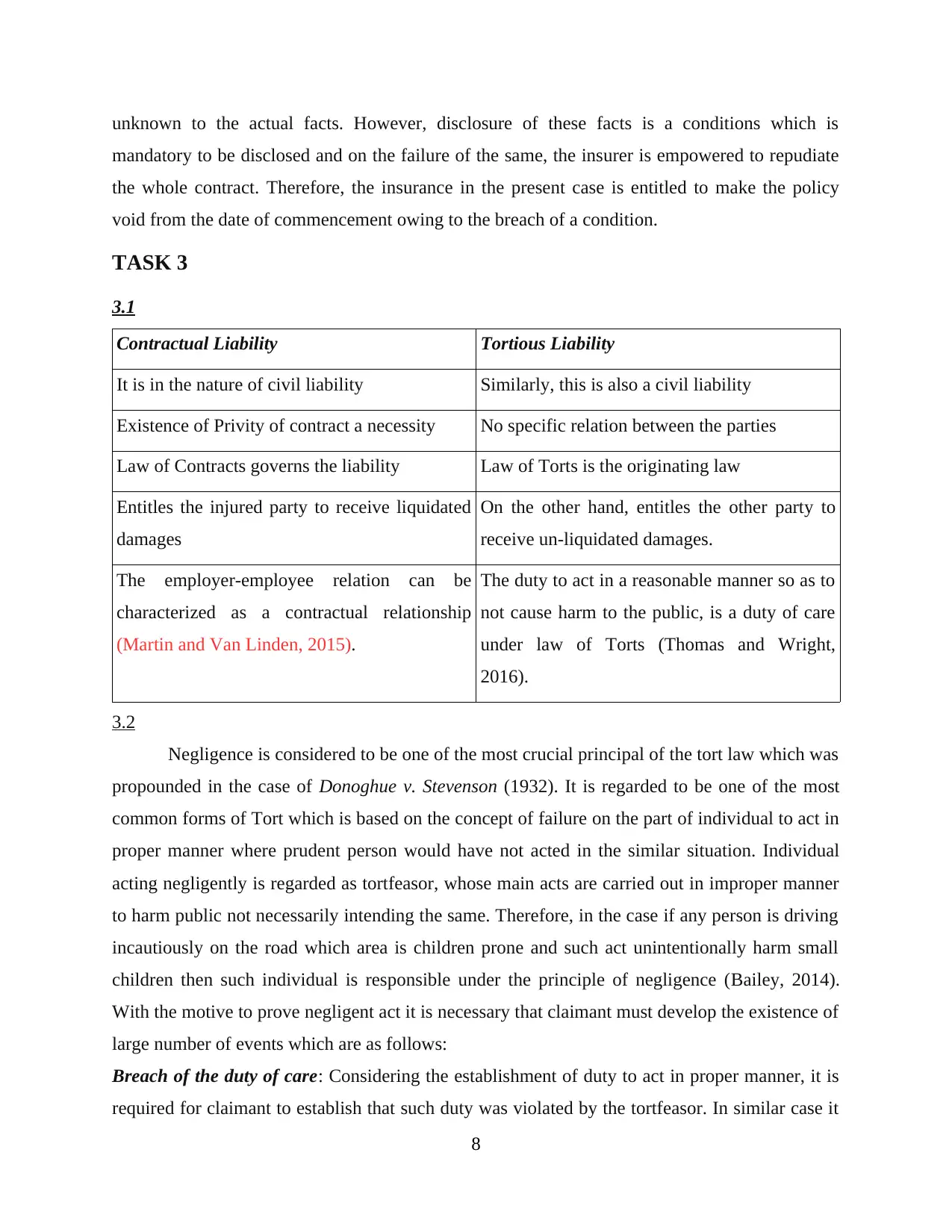
unknown to the actual facts. However, disclosure of these facts is a conditions which is
mandatory to be disclosed and on the failure of the same, the insurer is empowered to repudiate
the whole contract. Therefore, the insurance in the present case is entitled to make the policy
void from the date of commencement owing to the breach of a condition.
TASK 3
3.1
Contractual Liability Tortious Liability
It is in the nature of civil liability Similarly, this is also a civil liability
Existence of Privity of contract a necessity No specific relation between the parties
Law of Contracts governs the liability Law of Torts is the originating law
Entitles the injured party to receive liquidated
damages
On the other hand, entitles the other party to
receive un-liquidated damages.
The employer-employee relation can be
characterized as a contractual relationship
(Martin and Van Linden, 2015).
The duty to act in a reasonable manner so as to
not cause harm to the public, is a duty of care
under law of Torts (Thomas and Wright,
2016).
3.2
Negligence is considered to be one of the most crucial principal of the tort law which was
propounded in the case of Donoghue v. Stevenson (1932). It is regarded to be one of the most
common forms of Tort which is based on the concept of failure on the part of individual to act in
proper manner where prudent person would have not acted in the similar situation. Individual
acting negligently is regarded as tortfeasor, whose main acts are carried out in improper manner
to harm public not necessarily intending the same. Therefore, in the case if any person is driving
incautiously on the road which area is children prone and such act unintentionally harm small
children then such individual is responsible under the principle of negligence (Bailey, 2014).
With the motive to prove negligent act it is necessary that claimant must develop the existence of
large number of events which are as follows:
Breach of the duty of care: Considering the establishment of duty to act in proper manner, it is
required for claimant to establish that such duty was violated by the tortfeasor. In similar case it
8
mandatory to be disclosed and on the failure of the same, the insurer is empowered to repudiate
the whole contract. Therefore, the insurance in the present case is entitled to make the policy
void from the date of commencement owing to the breach of a condition.
TASK 3
3.1
Contractual Liability Tortious Liability
It is in the nature of civil liability Similarly, this is also a civil liability
Existence of Privity of contract a necessity No specific relation between the parties
Law of Contracts governs the liability Law of Torts is the originating law
Entitles the injured party to receive liquidated
damages
On the other hand, entitles the other party to
receive un-liquidated damages.
The employer-employee relation can be
characterized as a contractual relationship
(Martin and Van Linden, 2015).
The duty to act in a reasonable manner so as to
not cause harm to the public, is a duty of care
under law of Torts (Thomas and Wright,
2016).
3.2
Negligence is considered to be one of the most crucial principal of the tort law which was
propounded in the case of Donoghue v. Stevenson (1932). It is regarded to be one of the most
common forms of Tort which is based on the concept of failure on the part of individual to act in
proper manner where prudent person would have not acted in the similar situation. Individual
acting negligently is regarded as tortfeasor, whose main acts are carried out in improper manner
to harm public not necessarily intending the same. Therefore, in the case if any person is driving
incautiously on the road which area is children prone and such act unintentionally harm small
children then such individual is responsible under the principle of negligence (Bailey, 2014).
With the motive to prove negligent act it is necessary that claimant must develop the existence of
large number of events which are as follows:
Breach of the duty of care: Considering the establishment of duty to act in proper manner, it is
required for claimant to establish that such duty was violated by the tortfeasor. In similar case it
8
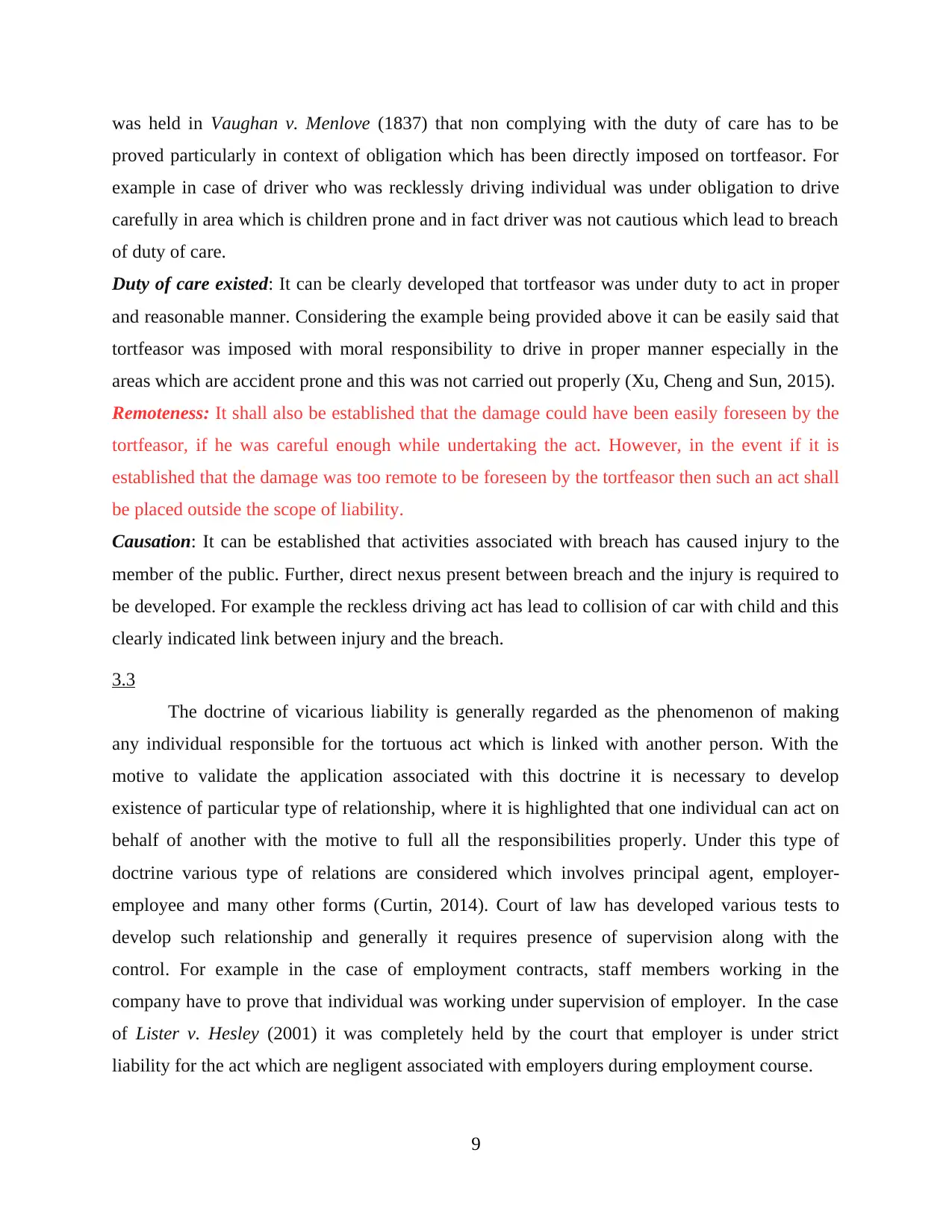
was held in Vaughan v. Menlove (1837) that non complying with the duty of care has to be
proved particularly in context of obligation which has been directly imposed on tortfeasor. For
example in case of driver who was recklessly driving individual was under obligation to drive
carefully in area which is children prone and in fact driver was not cautious which lead to breach
of duty of care.
Duty of care existed: It can be clearly developed that tortfeasor was under duty to act in proper
and reasonable manner. Considering the example being provided above it can be easily said that
tortfeasor was imposed with moral responsibility to drive in proper manner especially in the
areas which are accident prone and this was not carried out properly (Xu, Cheng and Sun, 2015).
Remoteness: It shall also be established that the damage could have been easily foreseen by the
tortfeasor, if he was careful enough while undertaking the act. However, in the event if it is
established that the damage was too remote to be foreseen by the tortfeasor then such an act shall
be placed outside the scope of liability.
Causation: It can be established that activities associated with breach has caused injury to the
member of the public. Further, direct nexus present between breach and the injury is required to
be developed. For example the reckless driving act has lead to collision of car with child and this
clearly indicated link between injury and the breach.
3.3
The doctrine of vicarious liability is generally regarded as the phenomenon of making
any individual responsible for the tortuous act which is linked with another person. With the
motive to validate the application associated with this doctrine it is necessary to develop
existence of particular type of relationship, where it is highlighted that one individual can act on
behalf of another with the motive to full all the responsibilities properly. Under this type of
doctrine various type of relations are considered which involves principal agent, employer-
employee and many other forms (Curtin, 2014). Court of law has developed various tests to
develop such relationship and generally it requires presence of supervision along with the
control. For example in the case of employment contracts, staff members working in the
company have to prove that individual was working under supervision of employer. In the case
of Lister v. Hesley (2001) it was completely held by the court that employer is under strict
liability for the act which are negligent associated with employers during employment course.
9
proved particularly in context of obligation which has been directly imposed on tortfeasor. For
example in case of driver who was recklessly driving individual was under obligation to drive
carefully in area which is children prone and in fact driver was not cautious which lead to breach
of duty of care.
Duty of care existed: It can be clearly developed that tortfeasor was under duty to act in proper
and reasonable manner. Considering the example being provided above it can be easily said that
tortfeasor was imposed with moral responsibility to drive in proper manner especially in the
areas which are accident prone and this was not carried out properly (Xu, Cheng and Sun, 2015).
Remoteness: It shall also be established that the damage could have been easily foreseen by the
tortfeasor, if he was careful enough while undertaking the act. However, in the event if it is
established that the damage was too remote to be foreseen by the tortfeasor then such an act shall
be placed outside the scope of liability.
Causation: It can be established that activities associated with breach has caused injury to the
member of the public. Further, direct nexus present between breach and the injury is required to
be developed. For example the reckless driving act has lead to collision of car with child and this
clearly indicated link between injury and the breach.
3.3
The doctrine of vicarious liability is generally regarded as the phenomenon of making
any individual responsible for the tortuous act which is linked with another person. With the
motive to validate the application associated with this doctrine it is necessary to develop
existence of particular type of relationship, where it is highlighted that one individual can act on
behalf of another with the motive to full all the responsibilities properly. Under this type of
doctrine various type of relations are considered which involves principal agent, employer-
employee and many other forms (Curtin, 2014). Court of law has developed various tests to
develop such relationship and generally it requires presence of supervision along with the
control. For example in the case of employment contracts, staff members working in the
company have to prove that individual was working under supervision of employer. In the case
of Lister v. Hesley (2001) it was completely held by the court that employer is under strict
liability for the act which are negligent associated with employers during employment course.
9
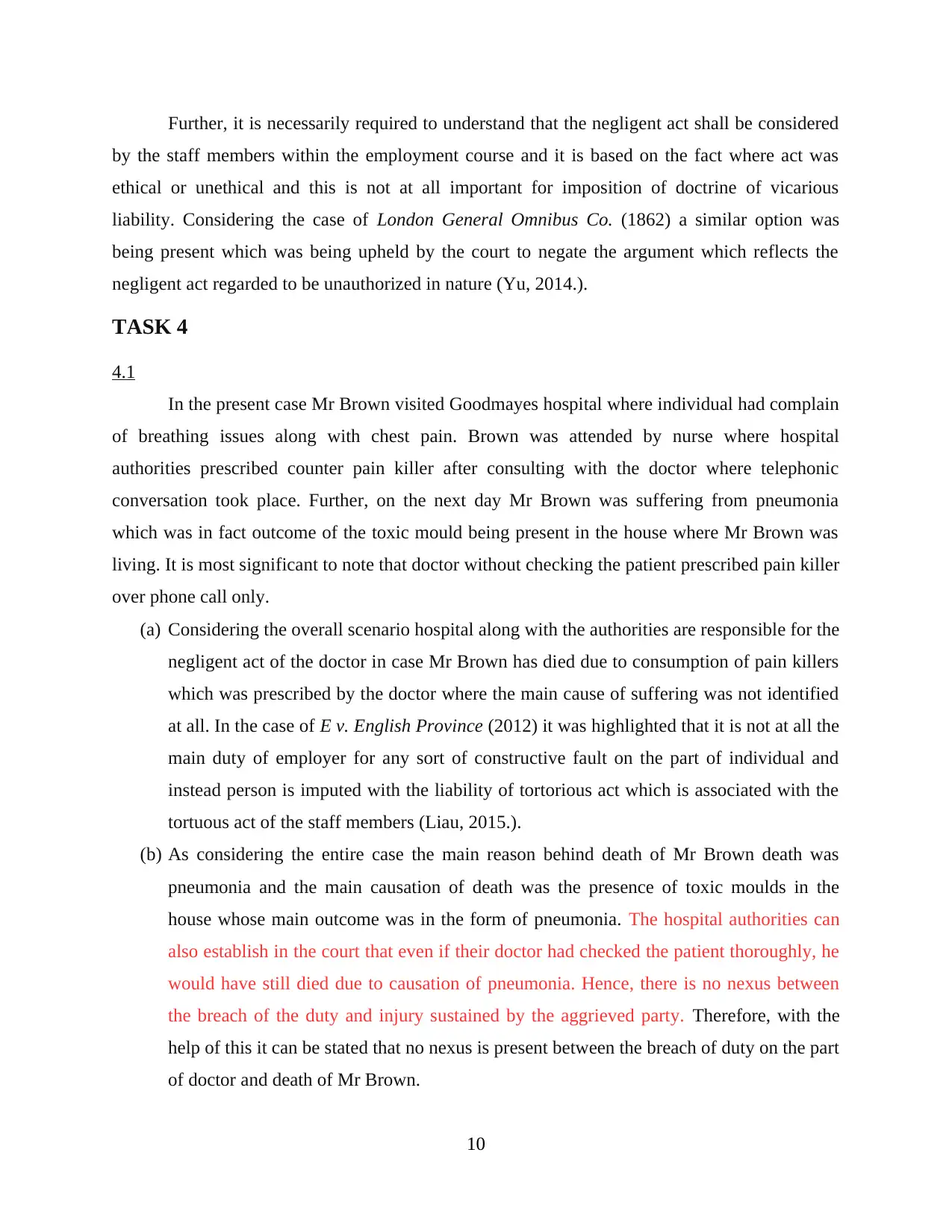
Further, it is necessarily required to understand that the negligent act shall be considered
by the staff members within the employment course and it is based on the fact where act was
ethical or unethical and this is not at all important for imposition of doctrine of vicarious
liability. Considering the case of London General Omnibus Co. (1862) a similar option was
being present which was being upheld by the court to negate the argument which reflects the
negligent act regarded to be unauthorized in nature (Yu, 2014.).
TASK 4
4.1
In the present case Mr Brown visited Goodmayes hospital where individual had complain
of breathing issues along with chest pain. Brown was attended by nurse where hospital
authorities prescribed counter pain killer after consulting with the doctor where telephonic
conversation took place. Further, on the next day Mr Brown was suffering from pneumonia
which was in fact outcome of the toxic mould being present in the house where Mr Brown was
living. It is most significant to note that doctor without checking the patient prescribed pain killer
over phone call only.
(a) Considering the overall scenario hospital along with the authorities are responsible for the
negligent act of the doctor in case Mr Brown has died due to consumption of pain killers
which was prescribed by the doctor where the main cause of suffering was not identified
at all. In the case of E v. English Province (2012) it was highlighted that it is not at all the
main duty of employer for any sort of constructive fault on the part of individual and
instead person is imputed with the liability of tortorious act which is associated with the
tortuous act of the staff members (Liau, 2015.).
(b) As considering the entire case the main reason behind death of Mr Brown death was
pneumonia and the main causation of death was the presence of toxic moulds in the
house whose main outcome was in the form of pneumonia. The hospital authorities can
also establish in the court that even if their doctor had checked the patient thoroughly, he
would have still died due to causation of pneumonia. Hence, there is no nexus between
the breach of the duty and injury sustained by the aggrieved party. Therefore, with the
help of this it can be stated that no nexus is present between the breach of duty on the part
of doctor and death of Mr Brown.
10
by the staff members within the employment course and it is based on the fact where act was
ethical or unethical and this is not at all important for imposition of doctrine of vicarious
liability. Considering the case of London General Omnibus Co. (1862) a similar option was
being present which was being upheld by the court to negate the argument which reflects the
negligent act regarded to be unauthorized in nature (Yu, 2014.).
TASK 4
4.1
In the present case Mr Brown visited Goodmayes hospital where individual had complain
of breathing issues along with chest pain. Brown was attended by nurse where hospital
authorities prescribed counter pain killer after consulting with the doctor where telephonic
conversation took place. Further, on the next day Mr Brown was suffering from pneumonia
which was in fact outcome of the toxic mould being present in the house where Mr Brown was
living. It is most significant to note that doctor without checking the patient prescribed pain killer
over phone call only.
(a) Considering the overall scenario hospital along with the authorities are responsible for the
negligent act of the doctor in case Mr Brown has died due to consumption of pain killers
which was prescribed by the doctor where the main cause of suffering was not identified
at all. In the case of E v. English Province (2012) it was highlighted that it is not at all the
main duty of employer for any sort of constructive fault on the part of individual and
instead person is imputed with the liability of tortorious act which is associated with the
tortuous act of the staff members (Liau, 2015.).
(b) As considering the entire case the main reason behind death of Mr Brown death was
pneumonia and the main causation of death was the presence of toxic moulds in the
house whose main outcome was in the form of pneumonia. The hospital authorities can
also establish in the court that even if their doctor had checked the patient thoroughly, he
would have still died due to causation of pneumonia. Hence, there is no nexus between
the breach of the duty and injury sustained by the aggrieved party. Therefore, with the
help of this it can be stated that no nexus is present between the breach of duty on the part
of doctor and death of Mr Brown.
10
Paraphrase This Document
Need a fresh take? Get an instant paraphrase of this document with our AI Paraphraser

4.2
Case 8
In the present scenario driver which was appointed by Chauffeur firm acted in negligent
way while picking up client from the airport. It was known that driver was drunk over limit and
the main outcome was accident where car crashed into lamp post. In accordance with all the facts
present business enterprise is vicariously liable for the act of driver as individual was acting in
the employment course. Further, considering the entire scenario it is required to develop
distinction between contract for service and the contract of service. The former one is
highlighting the key relationship between contractor client relationship and latter one is
highlighting the employer employee relationship as clearly represented in the case of Hawley v.
Luminar Lesiure Ltd. (2006). The present scenario is entirely linked with contract of service
which highlights the character of supervision and control. Therefore, considering this act
Chauffeur company is responsible for the negligence of driver. Moreover, it is necessarily
required to represent that driver was acting in the employment course and the overall act was
unauthorized in nature. In the case of London General Omnibus Co (1862) it was held that
making any employer responsible for the acts which are negligent and associated with employee
and it is required that act shall be within the course of employment (Oni-Ojo and Iyiola, 2014).
Further, it was clearly held that in case if unauthorized acts are being undertaken then also the
employer can be made vicariously liable for the negligent actions of employee.
. The present case is an example of contract of service as the Chauffeur Company can
exercise control over the activities of the driver. A distinction between 'contract of service' and
contract for service' can be established, wherein the former reflects the attributes of supervision
and control which is exercised by the principal over his agent. On the other hand, contract for
service refers to the situation wherein the principal has no control over the activities of the agent.
Moreover, though the actions of driver were unethical in nature, they were well within the course
of employment. Therefore, in this case client can easily claim damages from Chauffeur
Company.
Case 9
In the present case Mr Jones was working for a supermarket as a delivery driver where
individual was loading pallets in the vehicle and at the same time pallet slipped from his hand
and this caused injury to another colleague. Due to presence of such type of condition individual
11
Case 8
In the present scenario driver which was appointed by Chauffeur firm acted in negligent
way while picking up client from the airport. It was known that driver was drunk over limit and
the main outcome was accident where car crashed into lamp post. In accordance with all the facts
present business enterprise is vicariously liable for the act of driver as individual was acting in
the employment course. Further, considering the entire scenario it is required to develop
distinction between contract for service and the contract of service. The former one is
highlighting the key relationship between contractor client relationship and latter one is
highlighting the employer employee relationship as clearly represented in the case of Hawley v.
Luminar Lesiure Ltd. (2006). The present scenario is entirely linked with contract of service
which highlights the character of supervision and control. Therefore, considering this act
Chauffeur company is responsible for the negligence of driver. Moreover, it is necessarily
required to represent that driver was acting in the employment course and the overall act was
unauthorized in nature. In the case of London General Omnibus Co (1862) it was held that
making any employer responsible for the acts which are negligent and associated with employee
and it is required that act shall be within the course of employment (Oni-Ojo and Iyiola, 2014).
Further, it was clearly held that in case if unauthorized acts are being undertaken then also the
employer can be made vicariously liable for the negligent actions of employee.
. The present case is an example of contract of service as the Chauffeur Company can
exercise control over the activities of the driver. A distinction between 'contract of service' and
contract for service' can be established, wherein the former reflects the attributes of supervision
and control which is exercised by the principal over his agent. On the other hand, contract for
service refers to the situation wherein the principal has no control over the activities of the agent.
Moreover, though the actions of driver were unethical in nature, they were well within the course
of employment. Therefore, in this case client can easily claim damages from Chauffeur
Company.
Case 9
In the present case Mr Jones was working for a supermarket as a delivery driver where
individual was loading pallets in the vehicle and at the same time pallet slipped from his hand
and this caused injury to another colleague. Due to presence of such type of condition individual
11
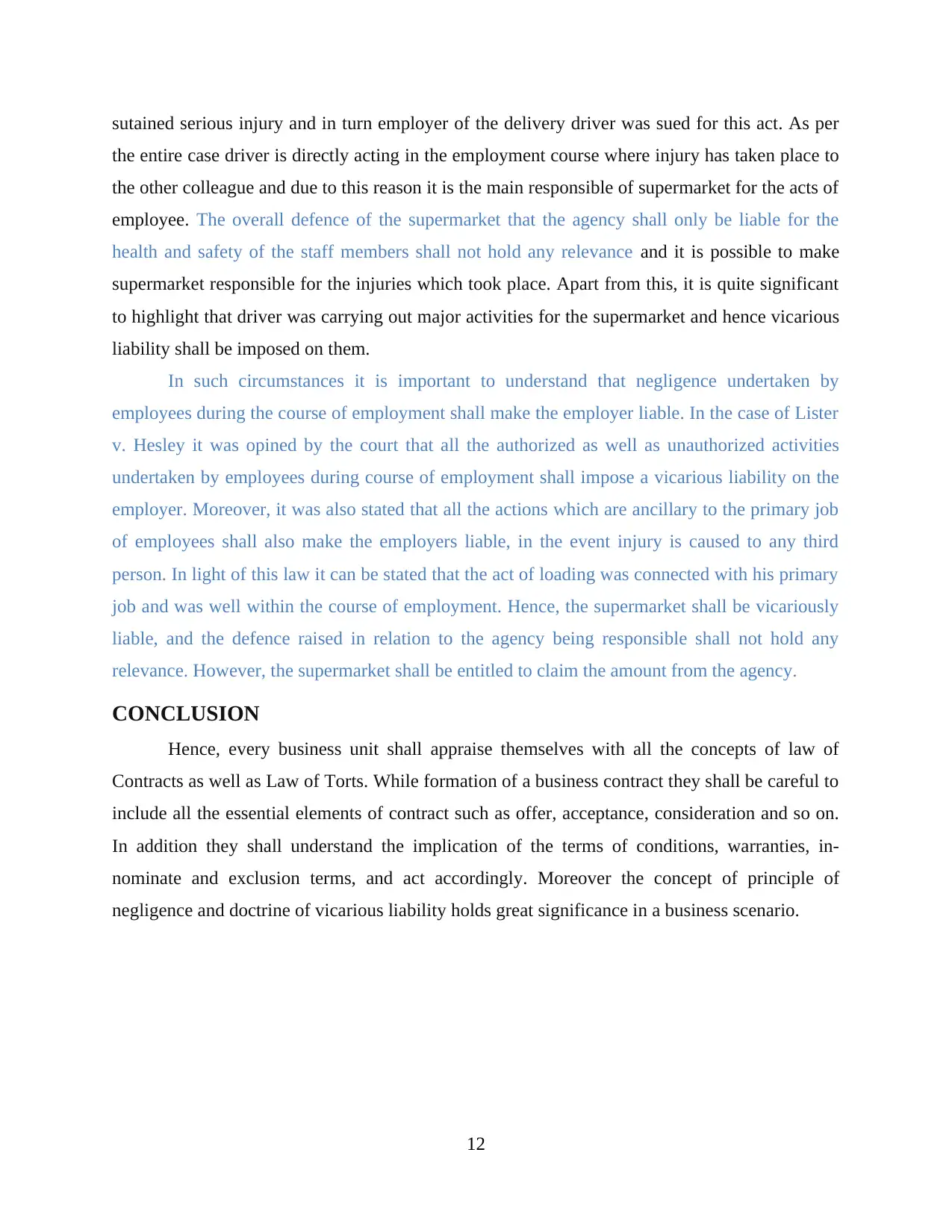
sutained serious injury and in turn employer of the delivery driver was sued for this act. As per
the entire case driver is directly acting in the employment course where injury has taken place to
the other colleague and due to this reason it is the main responsible of supermarket for the acts of
employee. The overall defence of the supermarket that the agency shall only be liable for the
health and safety of the staff members shall not hold any relevance and it is possible to make
supermarket responsible for the injuries which took place. Apart from this, it is quite significant
to highlight that driver was carrying out major activities for the supermarket and hence vicarious
liability shall be imposed on them.
In such circumstances it is important to understand that negligence undertaken by
employees during the course of employment shall make the employer liable. In the case of Lister
v. Hesley it was opined by the court that all the authorized as well as unauthorized activities
undertaken by employees during course of employment shall impose a vicarious liability on the
employer. Moreover, it was also stated that all the actions which are ancillary to the primary job
of employees shall also make the employers liable, in the event injury is caused to any third
person. In light of this law it can be stated that the act of loading was connected with his primary
job and was well within the course of employment. Hence, the supermarket shall be vicariously
liable, and the defence raised in relation to the agency being responsible shall not hold any
relevance. However, the supermarket shall be entitled to claim the amount from the agency.
CONCLUSION
Hence, every business unit shall appraise themselves with all the concepts of law of
Contracts as well as Law of Torts. While formation of a business contract they shall be careful to
include all the essential elements of contract such as offer, acceptance, consideration and so on.
In addition they shall understand the implication of the terms of conditions, warranties, in-
nominate and exclusion terms, and act accordingly. Moreover the concept of principle of
negligence and doctrine of vicarious liability holds great significance in a business scenario.
12
the entire case driver is directly acting in the employment course where injury has taken place to
the other colleague and due to this reason it is the main responsible of supermarket for the acts of
employee. The overall defence of the supermarket that the agency shall only be liable for the
health and safety of the staff members shall not hold any relevance and it is possible to make
supermarket responsible for the injuries which took place. Apart from this, it is quite significant
to highlight that driver was carrying out major activities for the supermarket and hence vicarious
liability shall be imposed on them.
In such circumstances it is important to understand that negligence undertaken by
employees during the course of employment shall make the employer liable. In the case of Lister
v. Hesley it was opined by the court that all the authorized as well as unauthorized activities
undertaken by employees during course of employment shall impose a vicarious liability on the
employer. Moreover, it was also stated that all the actions which are ancillary to the primary job
of employees shall also make the employers liable, in the event injury is caused to any third
person. In light of this law it can be stated that the act of loading was connected with his primary
job and was well within the course of employment. Hence, the supermarket shall be vicariously
liable, and the defence raised in relation to the agency being responsible shall not hold any
relevance. However, the supermarket shall be entitled to claim the amount from the agency.
CONCLUSION
Hence, every business unit shall appraise themselves with all the concepts of law of
Contracts as well as Law of Torts. While formation of a business contract they shall be careful to
include all the essential elements of contract such as offer, acceptance, consideration and so on.
In addition they shall understand the implication of the terms of conditions, warranties, in-
nominate and exclusion terms, and act accordingly. Moreover the concept of principle of
negligence and doctrine of vicarious liability holds great significance in a business scenario.
12
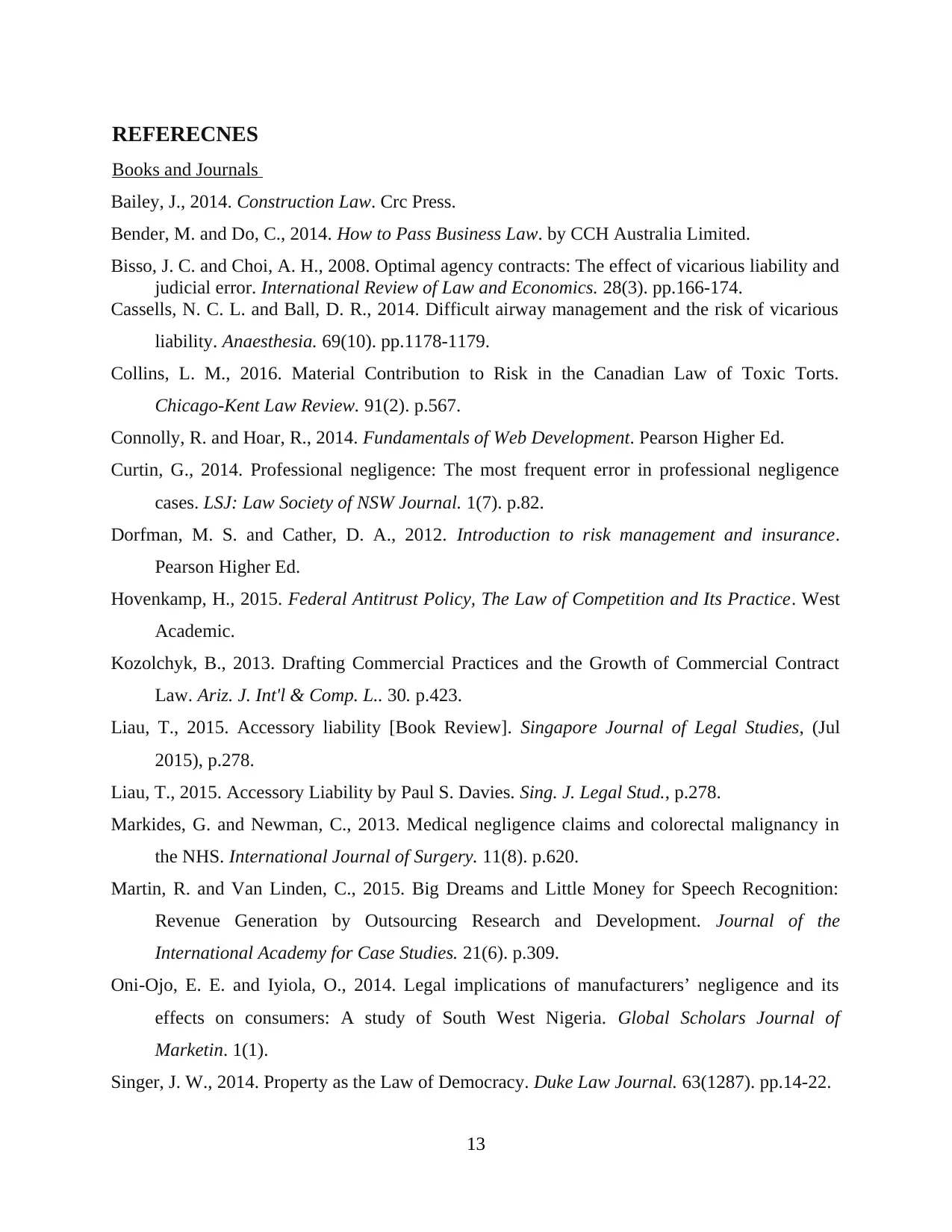
REFERECNES
Books and Journals
Bailey, J., 2014. Construction Law. Crc Press.
Bender, M. and Do, C., 2014. How to Pass Business Law. by CCH Australia Limited.
Bisso, J. C. and Choi, A. H., 2008. Optimal agency contracts: The effect of vicarious liability and
judicial error. International Review of Law and Economics. 28(3). pp.166-174.
Cassells, N. C. L. and Ball, D. R., 2014. Difficult airway management and the risk of vicarious
liability. Anaesthesia. 69(10). pp.1178-1179.
Collins, L. M., 2016. Material Contribution to Risk in the Canadian Law of Toxic Torts.
Chicago-Kent Law Review. 91(2). p.567.
Connolly, R. and Hoar, R., 2014. Fundamentals of Web Development. Pearson Higher Ed.
Curtin, G., 2014. Professional negligence: The most frequent error in professional negligence
cases. LSJ: Law Society of NSW Journal. 1(7). p.82.
Dorfman, M. S. and Cather, D. A., 2012. Introduction to risk management and insurance.
Pearson Higher Ed.
Hovenkamp, H., 2015. Federal Antitrust Policy, The Law of Competition and Its Practice. West
Academic.
Kozolchyk, B., 2013. Drafting Commercial Practices and the Growth of Commercial Contract
Law. Ariz. J. Int'l & Comp. L.. 30. p.423.
Liau, T., 2015. Accessory liability [Book Review]. Singapore Journal of Legal Studies, (Jul
2015), p.278.
Liau, T., 2015. Accessory Liability by Paul S. Davies. Sing. J. Legal Stud., p.278.
Markides, G. and Newman, C., 2013. Medical negligence claims and colorectal malignancy in
the NHS. International Journal of Surgery. 11(8). p.620.
Martin, R. and Van Linden, C., 2015. Big Dreams and Little Money for Speech Recognition:
Revenue Generation by Outsourcing Research and Development. Journal of the
International Academy for Case Studies. 21(6). p.309.
Oni-Ojo, E. E. and Iyiola, O., 2014. Legal implications of manufacturers’ negligence and its
effects on consumers: A study of South West Nigeria. Global Scholars Journal of
Marketin. 1(1).
Singer, J. W., 2014. Property as the Law of Democracy. Duke Law Journal. 63(1287). pp.14-22.
13
Books and Journals
Bailey, J., 2014. Construction Law. Crc Press.
Bender, M. and Do, C., 2014. How to Pass Business Law. by CCH Australia Limited.
Bisso, J. C. and Choi, A. H., 2008. Optimal agency contracts: The effect of vicarious liability and
judicial error. International Review of Law and Economics. 28(3). pp.166-174.
Cassells, N. C. L. and Ball, D. R., 2014. Difficult airway management and the risk of vicarious
liability. Anaesthesia. 69(10). pp.1178-1179.
Collins, L. M., 2016. Material Contribution to Risk in the Canadian Law of Toxic Torts.
Chicago-Kent Law Review. 91(2). p.567.
Connolly, R. and Hoar, R., 2014. Fundamentals of Web Development. Pearson Higher Ed.
Curtin, G., 2014. Professional negligence: The most frequent error in professional negligence
cases. LSJ: Law Society of NSW Journal. 1(7). p.82.
Dorfman, M. S. and Cather, D. A., 2012. Introduction to risk management and insurance.
Pearson Higher Ed.
Hovenkamp, H., 2015. Federal Antitrust Policy, The Law of Competition and Its Practice. West
Academic.
Kozolchyk, B., 2013. Drafting Commercial Practices and the Growth of Commercial Contract
Law. Ariz. J. Int'l & Comp. L.. 30. p.423.
Liau, T., 2015. Accessory liability [Book Review]. Singapore Journal of Legal Studies, (Jul
2015), p.278.
Liau, T., 2015. Accessory Liability by Paul S. Davies. Sing. J. Legal Stud., p.278.
Markides, G. and Newman, C., 2013. Medical negligence claims and colorectal malignancy in
the NHS. International Journal of Surgery. 11(8). p.620.
Martin, R. and Van Linden, C., 2015. Big Dreams and Little Money for Speech Recognition:
Revenue Generation by Outsourcing Research and Development. Journal of the
International Academy for Case Studies. 21(6). p.309.
Oni-Ojo, E. E. and Iyiola, O., 2014. Legal implications of manufacturers’ negligence and its
effects on consumers: A study of South West Nigeria. Global Scholars Journal of
Marketin. 1(1).
Singer, J. W., 2014. Property as the Law of Democracy. Duke Law Journal. 63(1287). pp.14-22.
13
Secure Best Marks with AI Grader
Need help grading? Try our AI Grader for instant feedback on your assignments.
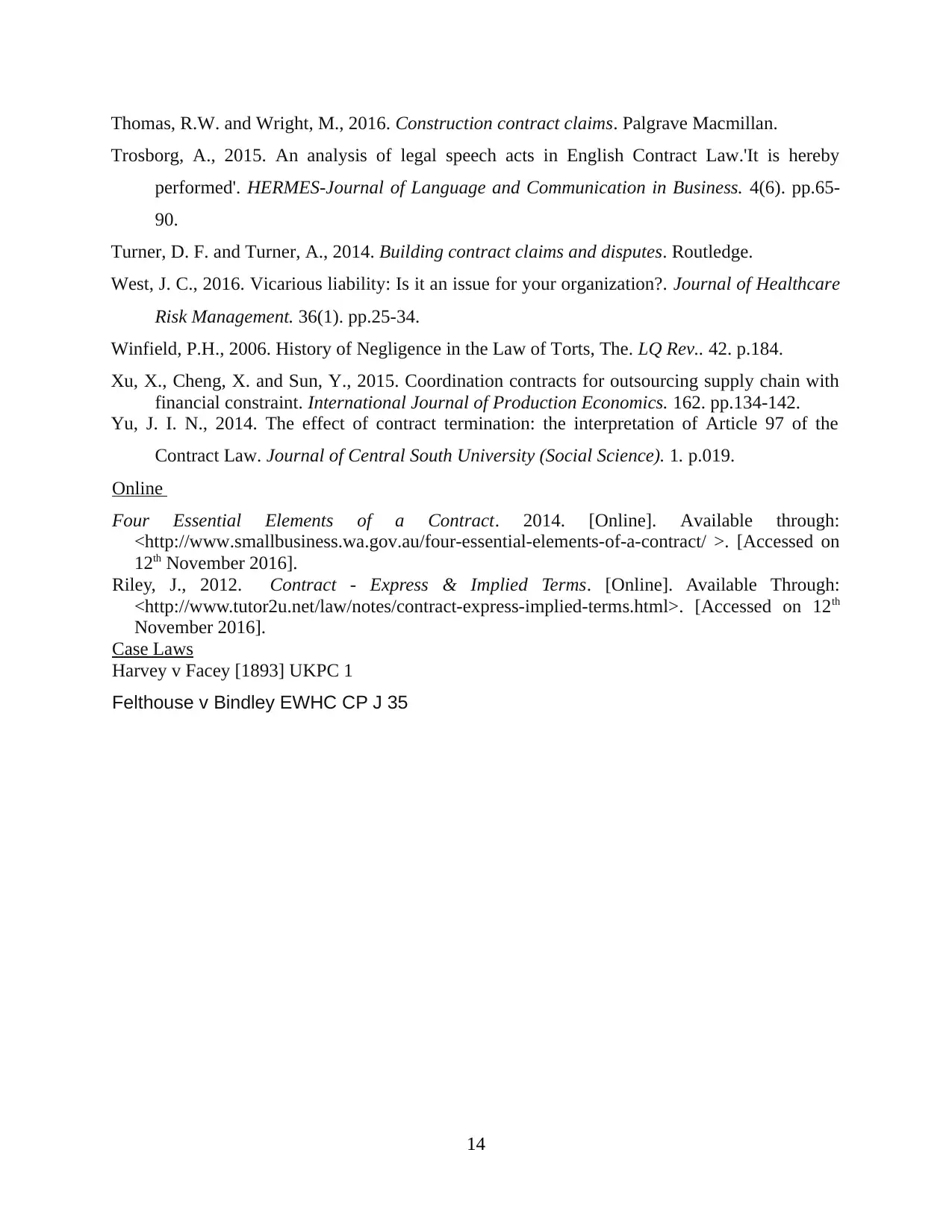
Thomas, R.W. and Wright, M., 2016. Construction contract claims. Palgrave Macmillan.
Trosborg, A., 2015. An analysis of legal speech acts in English Contract Law.'It is hereby
performed'. HERMES-Journal of Language and Communication in Business. 4(6). pp.65-
90.
Turner, D. F. and Turner, A., 2014. Building contract claims and disputes. Routledge.
West, J. C., 2016. Vicarious liability: Is it an issue for your organization?. Journal of Healthcare
Risk Management. 36(1). pp.25-34.
Winfield, P.H., 2006. History of Negligence in the Law of Torts, The. LQ Rev.. 42. p.184.
Xu, X., Cheng, X. and Sun, Y., 2015. Coordination contracts for outsourcing supply chain with
financial constraint. International Journal of Production Economics. 162. pp.134-142.
Yu, J. I. N., 2014. The effect of contract termination: the interpretation of Article 97 of the
Contract Law. Journal of Central South University (Social Science). 1. p.019.
Online
Four Essential Elements of a Contract. 2014. [Online]. Available through:
<http://www.smallbusiness.wa.gov.au/four-essential-elements-of-a-contract/ >. [Accessed on
12th November 2016].
Riley, J., 2012. Contract - Express & Implied Terms. [Online]. Available Through:
<http://www.tutor2u.net/law/notes/contract-express-implied-terms.html>. [Accessed on 12th
November 2016].
Case Laws
Harvey v Facey [1893] UKPC 1
Felthouse v Bindley EWHC CP J 35
14
Trosborg, A., 2015. An analysis of legal speech acts in English Contract Law.'It is hereby
performed'. HERMES-Journal of Language and Communication in Business. 4(6). pp.65-
90.
Turner, D. F. and Turner, A., 2014. Building contract claims and disputes. Routledge.
West, J. C., 2016. Vicarious liability: Is it an issue for your organization?. Journal of Healthcare
Risk Management. 36(1). pp.25-34.
Winfield, P.H., 2006. History of Negligence in the Law of Torts, The. LQ Rev.. 42. p.184.
Xu, X., Cheng, X. and Sun, Y., 2015. Coordination contracts for outsourcing supply chain with
financial constraint. International Journal of Production Economics. 162. pp.134-142.
Yu, J. I. N., 2014. The effect of contract termination: the interpretation of Article 97 of the
Contract Law. Journal of Central South University (Social Science). 1. p.019.
Online
Four Essential Elements of a Contract. 2014. [Online]. Available through:
<http://www.smallbusiness.wa.gov.au/four-essential-elements-of-a-contract/ >. [Accessed on
12th November 2016].
Riley, J., 2012. Contract - Express & Implied Terms. [Online]. Available Through:
<http://www.tutor2u.net/law/notes/contract-express-implied-terms.html>. [Accessed on 12th
November 2016].
Case Laws
Harvey v Facey [1893] UKPC 1
Felthouse v Bindley EWHC CP J 35
14
1 out of 17
Related Documents
Your All-in-One AI-Powered Toolkit for Academic Success.
+13062052269
info@desklib.com
Available 24*7 on WhatsApp / Email
![[object Object]](/_next/static/media/star-bottom.7253800d.svg)
Unlock your academic potential
© 2024 | Zucol Services PVT LTD | All rights reserved.





